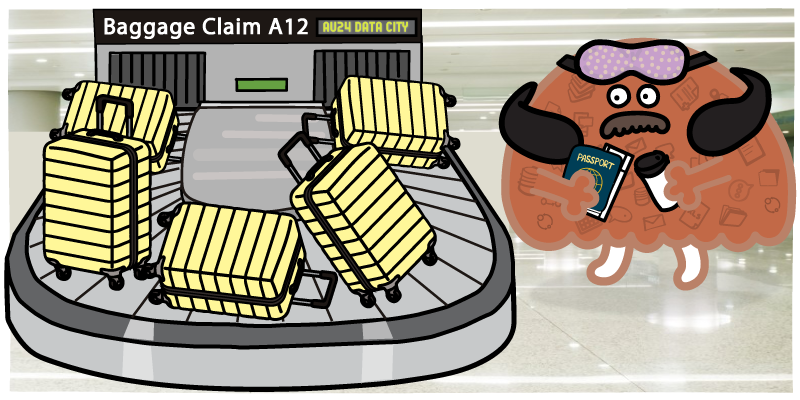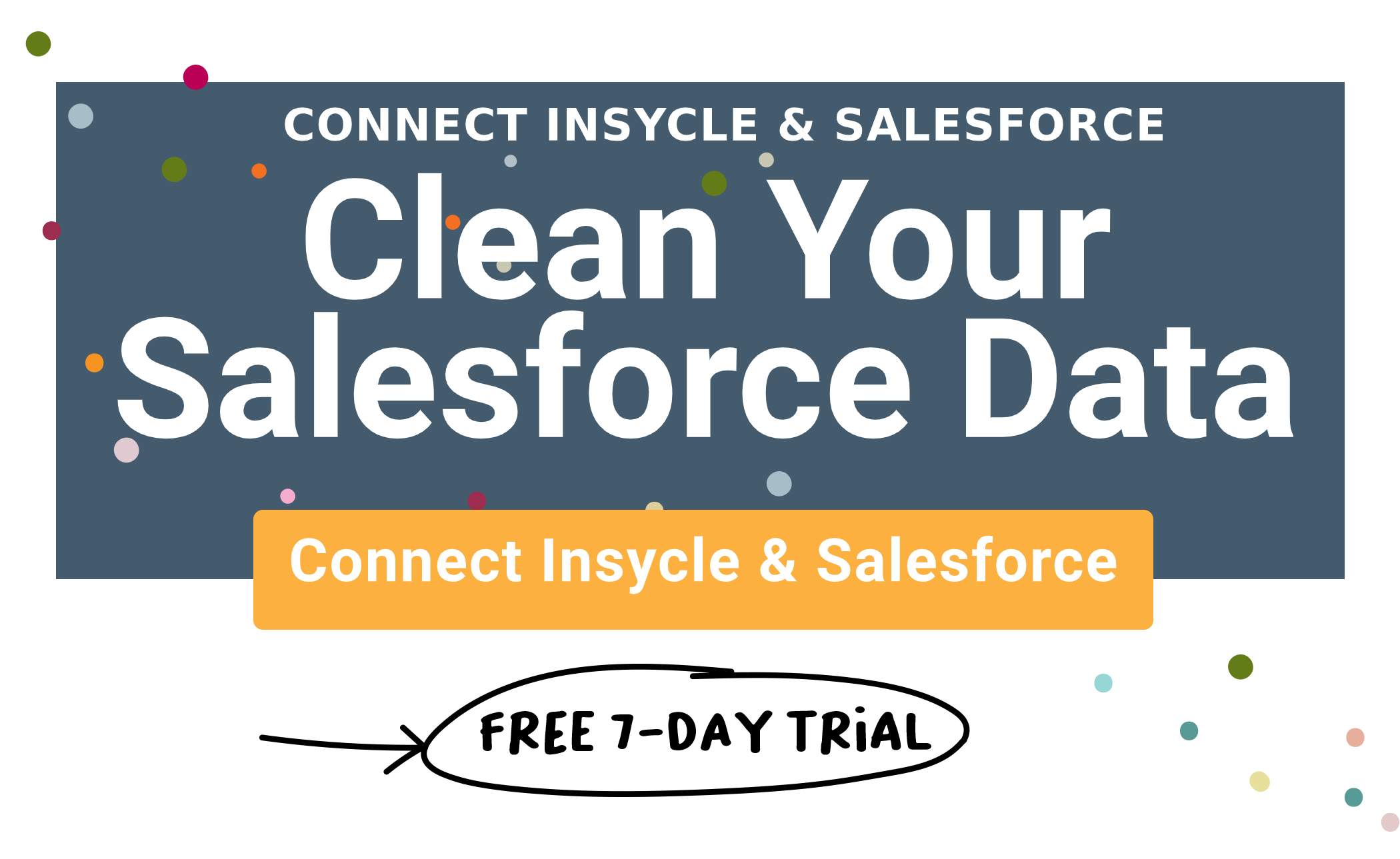Tired of combing through your Salesforce, HubSpot, or Intercom databases by hand to identify to remove duplicate entries?
Duplicate Salesforce data can be a serious problem. It can be a drain on your marketing budget. It can hinder your sales team. It keeps you from having a single customer view that you will use to guide your interactions with them throughout the customer lifecycle.
A recent survey of 1,200 organizations from EDQ asked what effect bad data had on their business. Here are the responses to the question — “Why Does Data Quality Matter?”
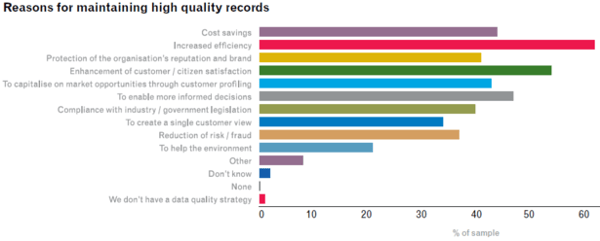
Source: eConsultancy
According to that same study, companies estimate that 22% of their contact records may contain bad data in some form. Answers from marketing and sales professionals were even grimmer — with the average response being that 30% of their records contained inaccurate data.
The real-world costs of inaccurate data are sky-high, with some estimates stating that bad data could cost U.S. businesses as much as $3 trillion per year.
Bad data and duplicate data don’t just affect a single interaction with a customer. They continue to affect interactions with them throughout the customer lifecycle — including marketing, sales, and customer support.
- What Are Duplicate Records?
- Why Do Salesforce Duplicate Records End Up in My Database?
- What Kind of Problems do Duplicate Records Cause?
- 6 Tips for Salesforce Duplicate Management
- A Powerful Solution for Salesforce Duplicate Management
What Are Duplicate Records?
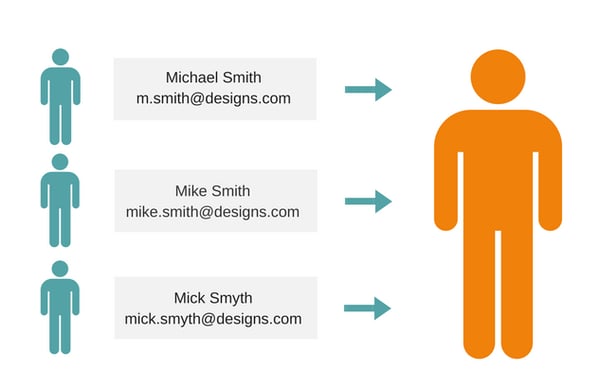
Source: Data2.xyz
Salesforce duplicates are records within your database that share data with another record. These records might be 100% carbon copies of another record or may be partial duplicates that contain only some duplicate information, such as email addresses, phone numbers, or names.
It is important to understand that partial duplicates can be just as (or more) damaging than full carbon copies. They are more likely to go undetected and work their way into marketing, sales, and support campaigns.
Why Do Salesforce Duplicate Records End Up in My Database?
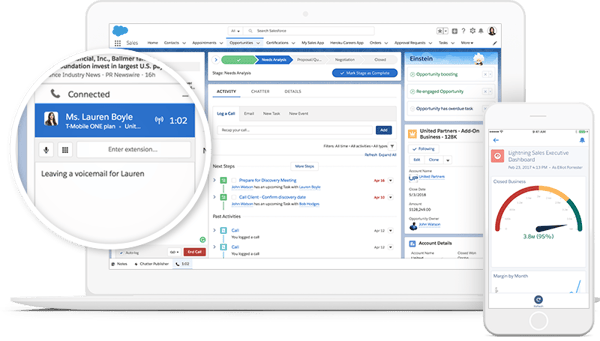
The key to Salesforce deduplication is understanding how and why the duplicate records were created in the first place. In most cases, duplicate records will come from many different sources. Some of those sources may be unique to your organization, particularly in companies that are using legacy software to input data into other critical systems.
Salesforce, HubSpot, and Intercom might have back-ends that are smart, but they aren't all-knowing. They aren't always able to determine when a record is a duplicate of another record. They don't have the deep merging capabilities that Insycle brings to the table.
For instance — what if you have two different “Joe Smith’s” in your system? You wouldn’t want Salesforce to automatically determine that the two were one in the same based on their name alone. There is a good chance that they are two completely separate Joe Smith’s.
For that reason, we don’t want Salesforce, or any other system, taking liberal guesses as to what are duplicates and what are not. Most platforms take a very strict approach to marking a record as a “duplicate.”
Salesforce has a number of duplicate rules and exceptions that it uses to identify duplicates within the system. Those duplicate rules can be customized to your specific organizational needs. However — this system is still very basic compared to Insycle and other platforms that focus specifically on Salesforce duplicate detection and cleaning.
There are a few different ways that duplicate data can end up in your Salesforce database:
- Import and export errors. When you move data around between platforms, there are likely to be some errors. Records being duplicated are one of the most common types of import and export errors. Remember — each platform has its own unique code and processes that drive the importation and exportation of data. There is no guarantee that those platforms are perfect. You should always run an audit or quality check on data that has been moved between platforms before loading it into your live sales and marketing databases.
- Human error by prospects and customers. Often, companies will connect their contact or lead capture forms directly to their Salesforce database. That means that when a customer fills the form out, a new record is automatically created in the database. But what happens when a prospect fills out the form twice? There may be weeks or months between each time they fill out the form. They may not even remember filling it out the first time. Still, they want more information or want to be contacted by one of your reps, so they fill it out. That can lead to duplicate records.
- Human error by your staff. Anytime that data is manually entered, there is a risk of errors. Maybe a prospect approached them outside of your usual channels, and they want to enter them into the system, but don’t realize that the prospect already had a record in your Salesforce database. Maybe a staff member found a previously outdated record, but mistakenly created a new one instead of updating the older record.
- Other automation errors. If you use custom-built automation or other tools like Zapier to move data between various platforms, you could accidentally create several records for the same entry. Connecting several systems creates more opportunity for errors.
There are many ways in which HubSpot and Salesforce duplicates can be created within your database. Those duplicates can cause serious issues that have a measurable effect on your ROI.
What Kind of Problems Do Duplicate Records Cause?
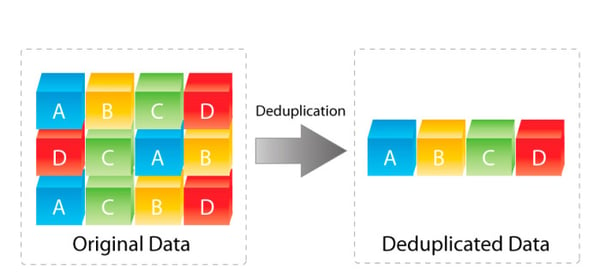
Source: Enterprise Storage Guide
Duplicate Salesforce records aren’t just a hassle — they have a measurable impact on your revenue when the problem is serious enough.
To understand why you need Salesforce duplicate management solutions to help you tackle the problem, you first need to understand exactly how duplicates can set your organization back.
Let’s take a look at some real-world examples of how duplicate Salesforce records can hinder your marketing initiatives, cause confusion among sales teams, and ultimately lead to fewer and lower-value sales.
Lack of a Single Customer View Lowers Productivity
An accurate single customer view is critical for the efficiency and confidence of your team members. Duplicates eat into the time of every major customer-facing team in your business — marketing, sales, support, and customer success.
When duplicate Salesforce CRM records are a consistent problem, your teams won’t have any confidence that the data that they access is the correct data for the prospect or customer. Once they have been burned by the problems that duplicate data creates, they’ll feel the need to double-check every record before engaging with a prospect.
Sales reps, for instance, depend on their ability to quickly contact prospects to maximize the sales that they generate. A problem with duplicate entries in your CRM can add an extra step to their process — checking for duplicates to make sure that they have the most up-to-date information for each prospect that they seek to contact.
That same issue extends to other teams as well. Marketing staff will want to double-check that they aren’t sending the same campaign to the same person twice. Customer success reps will want to check to make sure that they have the most up-to-date information about a prospect.
A single customer view is critical. Having confidence that your team can understand all engagements and interactions that your brand has had with a customer. It allows them to be specific and Intentional with their communication in ways that they simply can not when they don’t have confidence that they have access to the full picture.
Negative Brand Perception Among Prospects & Customers
Let’s put ourselves in the customer’s shoes. They’ve been engaging with your brand for a while. They’ve read blog posts, subscribed to your email list, and had several conversations with sales reps where they discuss the specific needs of their organization and how your solution can benefit them. =
They’re almost ready to buy. They just have a few more questions that they would like to have answered before they are ready to sign on the dotted line.
Then they set up a call with your sales rep, only to find that they don’t have any context for the conversations that they have had with previous sales reps. They’re covering topics that have already been discussed. They don’t have a full understanding of their full organizational needs. They may not even fully understand why they are interested in the solution that you provide.
It can be demoralizing for the customer and certainly does not reflect positively on your brand.
How can a customer have confidence that they are going to receive top-notch customer service from your team when sales reps don’t have any context from previous conversations? Will this be an ongoing problem? This is particularly problematic for companies that sell large B2B solutions that require a decent amount of collaboration and teamwork for onboarding and adoption.
This example makes it easy to see how duplicates and a lack of context can impair your ability to provide exceptional service to your customers, both pre-sale and post-sale.
6 Tips for Salesforce Duplicate Management
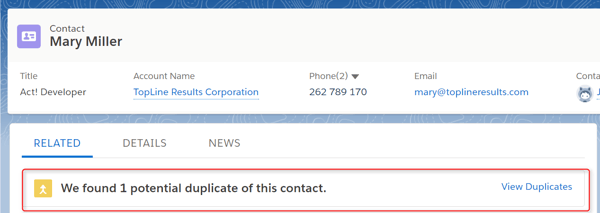
The good news is that just because you have duplicate record problems in Salesforce, HubSpot, or Intercom doesn’t mean that you will always have them.
There are some simple steps that any company can take to limit their exposure to duplicate records, protect against future duplicate problems, and ensure that their marketing, sales, support, and success teams have the right context for every interaction with a prospect or customer.
#1) Limit Human Data Entry
Most data errors can be traced back to human data entry, either by customers or your own team. Naturally, mistakes will be made when people are responsible for manually entering data. The only way to stop data entry errors is to limit where data entry is required.
If you have the option to pull data from another source instead of requiring manual input, do so. Additionally, you can add a quality check step on all manually entered data before it makes its way into your CRM. The time spent double-checking entries will pale in comparison to the costs of having duplicate data make its way into your customer relationship management system.
Most often, human data entry will create duplicate records and other inaccuracies in your system.
#2) Create Procedures for Creating New Manual Records
Many duplicate records are created manually when a member of your team enters a prospect into your system without first checking to make sure that they don’t already have a record. To limit this, make sure that you outline the steps and procedures that they should undergo when creating a new record, including checking to make sure that the customer or prospect does not already have a record in your system.
In creating step-by-step instructions for these tasks, you can ensure that they are being followed rather than relying on their ability to remember to check themselves. The more that you can spell out the exact steps for your team members, the fewer manual errors that you will see making their way into your system.
#3) Add a Data Audit Step Before Importing New Data
Data importing is one of the most common reasons for poor data quality and Salesforce duplicates. When you move data around between several different platforms, the chances of you encountering an error are high. Each platform might use different processing for reading, saving, and importing the data that conflict with one another.
Before importing new records from another platform, include a data quality audit step. You’ll be able to identify errors before they make their way into your system and limit duplicates in your Salesforce account.
#4) Include Proper Validation on All CRM-Connected Forms
If you have contact or information capture forms that are directly connected to your Salesforce CRM (or other CRM), make sure that you have proper validation in place. Phone numbers, for instance, could all be formatted in a specific way. Then, duplicate records will be easier for you to find within your system using those fields as a match case. Having the right matching rules in place will help you to identify and fix more duplicate contacts and accounts.
Proper validation also helps to keep your Salesforce data clean in general. Fields like phone number, city name, address, or email all have specific formatting considerations that must be taken into account to ensure quality in your CRM system.
With the right validation in place, you will never create duplicate records in the first place.
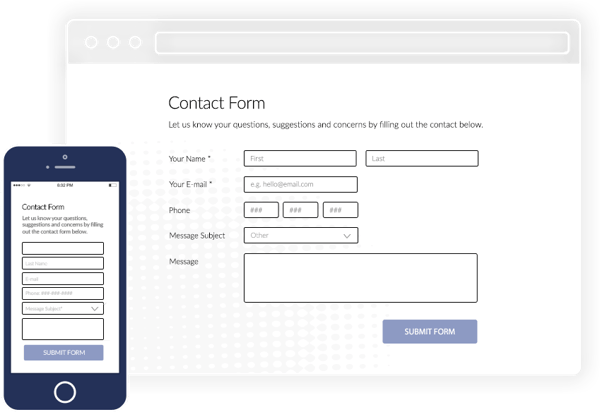
#5) Train Your Staff on Salesforce Duplicate Management
Teach your staff how to deal with Salesforce duplicate records. First, train them on how to avoid creating new duplicate records. Teach them how to look for existing records before creating a new one.
Teach them how to audit datasets before importing them into your system. Finally, teach them how to deal with duplicates that they find in the system. Should they delete a record? Merge them? Manually share data between the two records and delete one? How you handle duplicates will depend on your organizational needs.
In the end, you'll want to have processes in place for using matching rules and automation to identify and fix duplicates. Still, training your staff helps to ensure that everyone is on the same page.
Ultimately, having a well-trained and informed staff is an invaluable tool for Salesforce duplicate management and will help you to minimize the problem to the best of your ability.
#6) Invest in a Salesforce Deduplication Solution
While Salesforce does come with some duplicate management features, their built-in options are often not enough for larger companies that may be dealing with hundreds or thousands of duplicate entries.
Using something that can prevent duplicate records from reaching Salesforce in the first place is ideal. But at minimum, you need a system that can perform a duplicate check that digs a bit deeper than Salesforce' typical systems.
Instead, those companies should look to invest in a complete solution that can not only help them to deal with the duplicates that are already in their system but protect them against Salesforce duplicate records on an ongoing basis.
A Powerful Solution for Salesforce Duplicate Management
Insycle makes Salesforce, HubSpot, and Intercom duplicate management easy. Using Insycle, you can fix existing duplicates and prevent duplicate records from hitting your database in the first place. Our smart duplicate detection system is able to identify duplicate records using a wide variety of data fields. You can use our system for a one-time data cleanup session, or schedule ongoing automated Salesforce deduplication on a daily, weekly, or monthly basis.
You can give Insycle a try for free today! Just fill out the form below to get started with your free 7-day trial!
